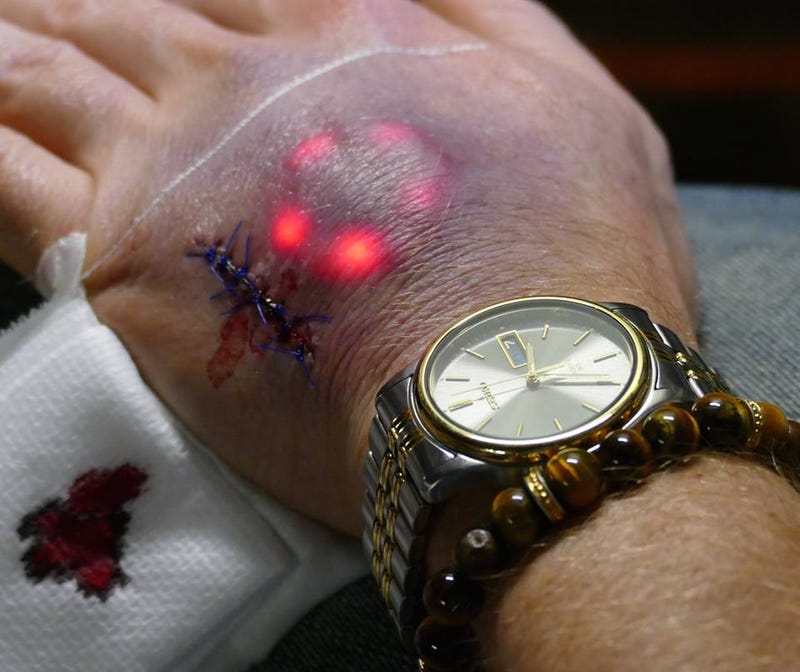Biohackers insert cyborg chips under skin to make tattoos glow
11/16/2015 / By Greg White

DIY biohackers from Pittsburgh-based Grindhouse Wetware have developed glowing cyborg chips that can be implanted under your skin.
The Northstar V1 chip is about the size of a large coin, making it considerably smaller than its predecessor, the Circadia 1.0 computer chip. The chip has a ring of LED lights designed to illuminate tattoos in a way that mirrors the bioluminescence of jellyfish.[1]
The procedure was performed by a Swedish tattoo artist, Jowan Österlund, during the Cyborg Fair in Dusseldorf, Germany. Once the device is inserted under the skin and activated, the Northstar can light up an existing tattoo.[1]
How to light up your skin
Whenever a magnet is placed on the device, the five LED lights begin blinking. The biohackers estimate the device can light up 10,000 times before it ceases to function. It is coated in silicon and dances to a three-volt battery. Once the device dies, it has to be surgically removed.

Tim Cannon takes credit for the creation of the chip. He is also one of the first men who had the device inserted under their skin.
The procedure consists of making a small insertion with a scalpel and peeling back the skin to make room for the chip. Blood flows out of the wounds as the device is inserted beneath the skin. The wound is then covered and stitched. The whole procedure takes about 15 minutes.
“Our first prototype, the Circadia, was so crazy that I could only use myself as a guinea pig in good conscience,” said Shawn Sarver, one of the biohackers. “But we produced a miniseries of the Northstar from the start to let additional team members and other people we know enjoy the chips.”[2]
“The stitches are extremely uncomfortable, they keep getting caught up in my clothing,” Sarver told sources, while reflecting upon his own procedure.[2]
“We think that it will light up 10,000 times before the batteries are empty and can’t be recharged,” Sarver says. “So we set everything to low power mode. After lighting up for ten seconds, the implants automatically go into sleep mode.”[2]
The Northstar V1 chip can perform a myriad of tasks, including connecting wirelessly over Bluetooth with an Android, reporting temperature fluctuations and sending text messages.
Motherboard’s Anna Neifer Shawn Sarver asked the biohackers why they created the device. Tim Cannon, Grindhouse Wetware co-founder, said: “You know, people from the biohacking community wanted it. They contacted us because they wanted to light up their tattoos. That’s how we generate our implants, we let the community inspire us.”[1]
As to why anyone would want to light up their tattoos with a probe inserted under their skin is anyone’s guess. Tattoos are popular for a variety of reasons. Some people get them as a piece of art or memorial, whereas others coat themselves in ink in order to reflect their personality and passion.
However, it seems that only a minute fraction of the tattoo community would be willing to graft a cyborg under their skin for the sake of art or freedom of expression. Whatever audience Grindhouse serves, it must be a very specific community.
Cyborg 2.0
Looking forward, the team hopes to sell at least 100 Northstar V1 devices through tattoo studios worldwide. The chip should be available next year.[1]
The company is currently working on the second version of the device, christened Northstar Version 2, which will include Bluetooth connectivity. This will enable people to control various devices from afar, like a television set, with nothing but a wave of a hand.
“Everyone is excited about how small the Northstar V1 is, because the last implant I had was the size of a pack of cigarettes,” Cannon told Motherboard.[1]
“But it’s still way too big. We want to get it much smaller. We want to transform science fiction into reality.”[1]
Sources include:
[1] DailymMail.co.uk
Tagged Under: biohackers, Cyborg Fair, cyborgs, Dusseldorf, glowing tattoos, Grindhouse Wetware, tattoos


















